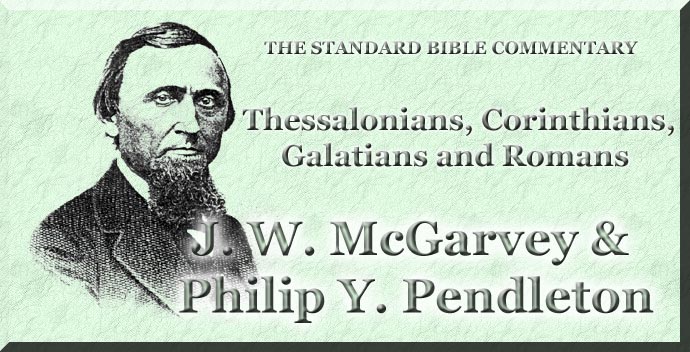FIRST EPISTLE TO THE THESSALONIANS.
INTRODUCTION.
On his second missionary journey Paul founded
the first European church at Philippi.
Continuing his journey one hundred miles farther, he came to Thessalonica, which
was the capital of the second Roman district of the province of Macedonia.
It was a large and important commercial city, containing much wealth and
learning. To this day it is the second city in European Turkey, ranking next to
Constantinople, and has between 75,000 and
100,000 inhabitants. It is now called Saloniki. When
Paul entered it, A. D. 52, the Greek element preponderated, and Roman colonists
were next in number. The Jews also were there, and had at least one synagogue.
In this synagogue Paul and Silas and Timothy began their work, but after three
Sabbaths they were apparently ejected from that place of worship. Then
an uproar was raised by the Jews, and Paul and Silas were led out of the
city by night, and conducted by brethren to Beroea. It is not unlikely that Paul was in Thessalonica
longer than three weeks, for he succeeded in founding a church there before
persecution compelled him to retire. Immediately south of Thessalonica were the
snowclad slopes of Mount
Olympus, the supposed seat of the
mythical gods of Greece.
The infant church was therefore not only endangered by the opposition of the
Jews, but was also liable to assault on the part of the pagans, being so near
one of their geographical centers. As might be expected, Paul felt keenly the
perils of this small band of raw, half-instructed Christians, and (probably
while in Beroea) he twice tried to return to them, but
was hindered by Satan. Then trouble broke out in Beroea,
and Paul was hurried off alone to
Athens. Timothy, either after [1] his
arrival in Athens, or probably before he left Beroea, was ordered by Paul to go and visit the church at
Thessalonica, and bring him word as to its condition. From
Athens
Paul came to Corinth,
and here was joined by Silas and Timothy, the latter bringing the apostle a
fairly good report of the church at Thessalonica. Timothy, however, seems to
have reported that the Thessalonians had not wholly forsaken the sensuality and
covetousness which had characterized them as pagans, and Paul exhorts them to
forsake these sins. Then, too, the Thessalonians had a wrong view of the second
coming of the Lord. They expected it to take place in the near future, and had
gotten the notion that only those who were alive at the Lord's coming would
participate in the glories and joys of that hour. Paul corrects this idea also
by showing that the resurrection of Jesus guarantees the resurrection of those
who believe in him. The doctrines of the Epistle are simple and practical, for
the Judaizing questions discussed in Galatians and
Romans. and the Gnostic errors handled in Colossians
and Ephesians, had not yet been raised. As a whole, the Epistle may be taken as
an argument tending to confirm the faith of the Thessalonians in the divine
origin of the gospel. That the gospel is of God is shown in four ways: 1. It had been attested by miracles. 2. It had been preached to
the disadvantage of its ministers and despite bitter opposition. 3. It set forth
precepts the sanctity of which were worthy of heaven. 4. Its author was divine,
having risen from the dead and become the author of the resurrection. On his
third journey Paul must have visited Thessalonica frequently, and these visits,
together with his Epistles, were not without their fruits, for Thessalonica was
for centuries the bulwark of Christian faith in the East, and long resisted the
invading forces of the Mohammedans. When word went forth in A. D. 1430 that
Thessalonica had fallen, all Christendom was dismayed. [2]
|

 Home
Home What's New
What's New Bible
Bible Photos
Photos Hiking
Hiking E-Books
E-Books Genealogy
Genealogy Profile
Free Plug-ins You May Need
Profile
Free Plug-ins You May Need
 Get
Java
Get
Java.png) Get Flash
Get Flash Get
7-Zip
Get
7-Zip Get Acrobat Reader
Get Acrobat Reader Get
TheWORD
Get
TheWORD
